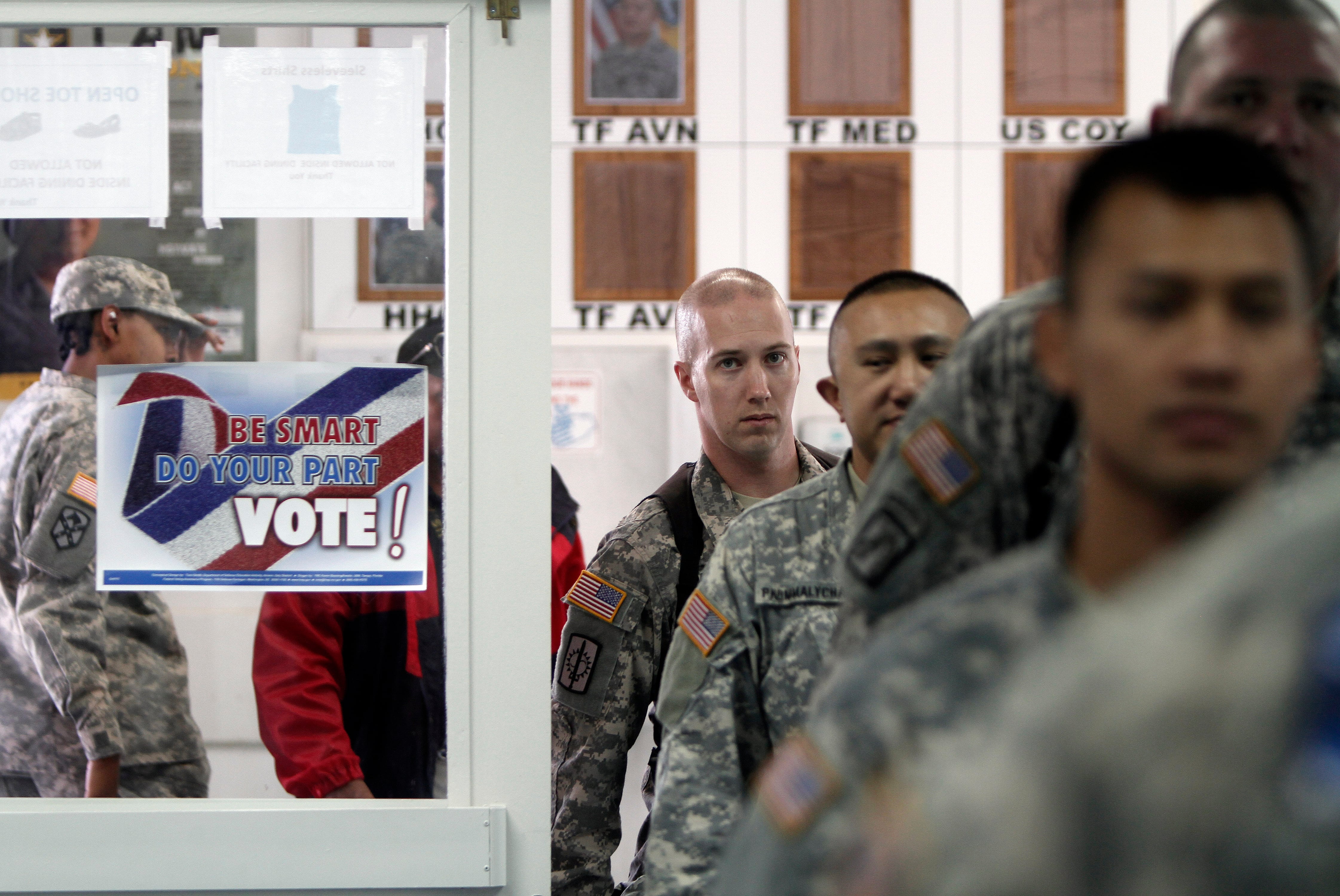Army Maj. Erica Vandal has spent her entire adult life on active duty.
A graduate of the U.S. Military Academy, she’s served her country proudly for nearly 14 years.
Military service is in her blood. Her father also graduated from West Point and served in the Army for 40 years. One of her brothers is a former Marine Corps pilot, and another is an active-duty Navy pilot.
“The military is a critical component of my identity,” Vandal said.
As a transgender soldier, she now finds herself battling for her right to continue her family’s legacy of service. Soon after taking office, President Donald Trump called for the imminent dismissal of all transgender service members — a policy introduced through an executive order Jan. 27 and further outlined in a Pentagon memo on Feb. 26.
The memo says individuals with a diagnosis or symptoms of gender dysphoria have medical, surgical and mental health constraints “incompatible with the high mental and physical standards necessary for military service.”
The administration’s policy immediately ignited fierce legal disputes in several courts around the country over the constitutionality of the ban. Multiple service members, lawyers and advocates said the rollout was rushed and sloppy, creating confusion among branches over how to enforce it and ambiguity for service members over how to comply.
Information presented as facts by the government was also incorrect, they argued, and painted an inaccurate portrait of everything from the cost of gender-affirming care to the ability of transgender troops to do their jobs.
Defense officials have said that about 4,000 transgender individuals are currently serving in the military, both on active duty and in the reserves. In the face of the ban, Vandal and other transgender service members told Military Times they were dedicated to continuing in their posts.
The ban went back on the promise Vandal said was made to transgender service members in 2016, when the Defense Department announced a policy permitting transgender people to serve openly in the military. Vandal is currently suing the Trump administration over the ban, along with dozens of other plaintiffs in Talbott v. Trump, a case being heard in the U.S. District Court for the District of Columbia.
The Defense Department and Justice Department declined to comment on the case or answer other questions about the new transgender service policy.
One part of the Feb. 26 memo claimed the physical and mental health constraints of transgender service members prevented them from meeting military standards, such as readiness, lethality, honesty and integrity. Regarding that section, Vandal said, “It was a difficult thing to hear … how both my service and my personhood was characterized by the government.”
The Trump administration’s executive order was even more damning in its characterization of transgender troops.
“Beyond the hormonal and surgical medical interventions involved, adoption of a gender identity inconsistent with an individual’s sex conflicts with a soldier’s commitment to an honorable, truthful, and disciplined lifestyle, even in one’s personal life,” the executive order stated. “A man’s assertion that he is a woman, and his requirement that others honor this falsehood, is not consistent with the humility and selflessness required of a service member.”
But lawyers and advocates who spoke to Military Times fundamentally disagreed — not only with what they characterized as the ban’s blatant discrimination against transgender personnel — but the rationale behind the ban. They pointed to a lack of evidence, and outright mistreatment, of those who had served their country honorably.
Legal battles unfold
One day after Trump signed the executive order, his administration was hit with the Talbott v. Trump lawsuit.
GLAD Law and the National Center for Lesbian Rights, or NCLR, first filed the lawsuit on behalf of six active-duty service members and two other people seeking enlistment. Since then, 26 other plaintiffs have joined the case.
After several months of court proceedings, U.S. District Judge Ana Reyes issued a preliminary injunction March 18, blocking the ban on transgender troops. She described the Defense Department’s new policy as a “solution in search of a problem” and counterproductive to national security.
The government filed a motion for an emergency stay, which, if granted, would stop the preliminary injunction from taking effect and reinstitute the ban. The court had yet to rule on the stay as of Wednesday.
Shannon Minter, one of NCLR’s lead attorneys in the Talbott case, along with GLAD attorney Jennifer Levi, were instrumental in shutting down the first Trump administration’s attempt at a transgender military ban in 2017.
“It violates the requirement, the constitutional requirement, of equal protection,” Minter said of the new ban.
The main objective of the courts, he explained, was to determine whether the DOD policy furthered the agenda the department said it was enacted to advance, including increased lethality, cohesion and all the other tenets laid out in the memo and executive order.
“The question here for the courts is, ‘Does banning transgender people serve those interests?’” Minter said.
The case has also brought up concerns over a potential invasion of privacy.
A March 21 memo from the Office of the Under Secretary of Defense said the Defense Department would sift through medical records as the primary means to identify transgender service members for dismissal. This tally wouldn’t only target the records of transgender troops, Minter said, but it would involve all service members’ records — a mass violation of personal information.
The military’s proposed method would also risk outing service members as transgender who hadn’t shared that information with their fellow troops, according to Minter.

On March 28, another federal court sided with plaintiffs in a separate case involving transgender service members suing the government over the ban. U.S. District Judge Benjamin Hale Settle issued a nationwide preliminary injunction, also blocking the executive order and DOD policy. The government filed a notice of appeal in both the Talbott and Shilling rulings.
A months’ long legal showdown involving filings and oral arguments is now expected to follow, and depending on the outcome, either side could ask for the Supreme Court to hear the case. If the highest court in the land chose to listen, it would delay a final decision even longer.
Some advocates expressed optimism, despite the possibility of an extended timeline with a host of potential outcomes.
“Nothing gets solved in a week, and we’re in the fight for the long haul,” said Christopher Hooper, co-Founder of SPARTA, a nonprofit comprised of transgender service members and veterans. “To deny any patriotic American the right to serve is unwholly anti-American.”
Inconsistent information
Five more years — that’s all the time one transgender Navy lieutenant had left to reach their 20-year mark in the military and qualify for retirement pay, having already served for 15.
But their plans quickly changed when the ban on transgender troops was released. They began thinking about their future in the military, and whether they had one.
The Navy lieutenant, River, said there was no way to take the policy other than personally. Military Times granted River the use of an alias due to their fear of retaliation from the Defense Department.
“In this current political environment, I don’t see that I am going to be able to survive for five more years as a transgender person in the Navy,” River said. “It’s not getting easier for me to exist as myself.”
River sought to voluntarily separate from the military after the announcement, but that separation process has become convoluted. A combination of the ongoing legal battles, confusion over how to enforce the new policy and the mirky logistics surrounding dismissals of transgender troops had devolved the situation into chaos, advocates and lawyers said.
The Pentagon’s Feb. 26 memo, as well as a DOD release two days later, stated transgender service members had 30 days from the date of the memo to voluntary separate from the military. Doing so would make them eligible for voluntary separation pay that equaled twice the amount of an involuntary separation, the memo promised. Among other incentives, the guidelines said those who voluntarily separated would not have to repay bonuses.
Waivers would be granted for transgender troops to remain in the military if there was a “compelling government interest in retaining the service member who directly supports warfighting,” the memo said. The Pentagon added the caveat that troops had to demonstrate they never attempted to transition to another sex besides the one they were assigned at birth, and they must follow the military standards of the sex they were assigned at birth.
River decided to take the voluntary separation because they expected the process to only get more complex with time. They guessed there would be more ambiguity to policies, more injunctions and court proceedings and more confusion over how to enforce the ban. Already, River argued, there was a gap in guidance. Commanders didn’t know how to respond to the executive orders, the memos and the administrative orders, they said.
This vagueness could embolden bad actors to discriminate against transgender service members, River argued. While many leaders were doing right by their personnel, treating them with dignity and respect, River was uncertain about how they would be treated moving forward.
“I don’t want to be at the whim of somebody’s personality,” River said.
RELATED

There appeared to be confusion at first over the exact deadline for service members to voluntarily separate, with different services listing different dates. Lindsay Church, executive director and co-founder of Minority Veterans of America, argued the lack of continuity was representative of the military’s haphazard handling of the new policy.
Citing the difference in deadlines, Minter described the whole process as “utter chaos.” Service members had no time to make a massive decision, and they were asked to do so with unclear information and no guidance, he said.
“This is the complete opposite of any sort of respectful, orderly process,” Minter said. “This is no way to run anything, much less the military of the United States, and it’s no way to treat these service members.”
After the Shilling ruling, the Navy released an administrative order that paused voluntary and involuntary separations until further notice. Spokespeople for the Air Force and Army told Military Times they had received guidance to pause the processing of voluntary and involuntary separations. A Coast Guard spokesperson said in an emailed statement that the service had “not initiated action to separate transgender service members.”
As March came to an end, River was told their voluntary separation was on hold.
“It’s just another reminder that as long as I’m in the military, I don’t have agency over mine or my family’s lives,” River told Military Times during the confusion.
An end to gender-affirming care
The Trump administration has asserted that transgender people have medical and surgical health constraints that are incompatible with the standards of military service. But for River, that is not their lived experience.
The idea of transgender service members requiring extensive medical care was a “disinformation campaign,” River claimed.
“My gender-affirming care takes five minutes every Sunday.”
The Defense Department and Justice Department declined to comment about the health care costs of transgender troops for gender-affirming care. They also declined to provide any details about the medical and psychological constraints of transgender service members.
In January, officials from the Congressional Research Service said the Defense Department spent about $15 million between January 2016 and May 2021 to provide gender-affirming care to 1,892 active-duty troops, at a cost of about $8,000 per person.
The Pentagon’s Feb. 26 memo announced the Defense Department would no longer sanction transgender service member’s gender-affirming care, including gender-affirmation surgery or hormone therapy. For certain service members who began hormone therapy prior to the memo’s release, there was a possibility they could continue treatment until their separation, the memo stated.
On March 17, the U.S. Department of Veterans Affairs announced an end to transgender-related care for veterans.
Allison Jaslow, a former Army captain and the CEO of Iraq and Afghanistan Veterans of America, said she opposed the administration’s move to draw the line over medical care for transgender troops and veterans.
“The checks that the American taxpayer has been writing to invest in these service members, in many cases, has been significant,” Jaslow said. “And then we’re going to get cheap on their medical care, whether they’re still serving or if they’re a veteran?”
The rationale for their expulsion didn’t make sense to her, either. Some transgender service members are serving as Army Special Forces soldiers, who Jaslow described as the “baddest of the baddest asses.” The argument that they negatively affect lethality doesn’t hold up, she contended.

Policies already exist to maximize the military’s lethality and war-fighting capabilities, insisted one transgender Army officer who spoke to Military Times.
Army troops must take a physical fitness test twice a year, pass marksmanship tests and clear other hurdles to remain in the service, said the officer, Sarah. Military Times granted Sarah the use of an alias, out of fear that attention from the public would distract from her unit’s mission.
“The trans people that are in the military right now, they meet the standard, because if they didn’t, they wouldn’t be here,” she said.
Advocates argued the military isn’t in a position with its recruiting numbers to kick out service members who meet the necessary standards.
“We are facing recruiting and retention challenges,” said Lucas Schleusener, CEO of Out In National Security, a nonprofit that supports LGBTQ national security professionals. “We should have every possible talent in the pool.”
A commitment to serve
Maj. Erica Vandal had wanted to join the military since she was a kid. Now that her dream is a reality, she wished it wouldn’t end.
“I want to be able to continue my career, to continue this lifelong passion of mine,” she said.
If the ban does go through, Vandal said she’d try to find another way to serve her country.
Sarah, who has served in the Army for 17 years, said the ban, legal battles and back and forth on guidelines over the past two months were distractions from performing in her role as a warfighter. Even with the introduction of the policy targeting transgender troops like her, she was trying to focus on the work, she said. People depended on her to be excellent every day, and that’s what she plans to keep doing.
“I have a commitment to my country,” she said.
For River, even as they processed the possibility of the ban being enacted and their voluntary separation going through, they were holding onto the possibility of a way to continue on — of finding a path forward where they could still put on their uniform like they had been for over a decade.
“I just want to serve,” they said.
Riley Ceder is a reporter at Military Times, where he covers breaking news, criminal justice, investigations, and cyber. He previously worked as an investigative practicum student at The Washington Post, where he contributed to the Abused by the Badge investigation.




